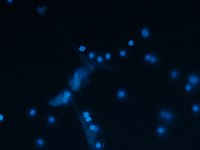
Photo from wikipedia
Neutrophils are immune cells involved in several inflammatory and homeostatic processes. Their capacity to release cargo can be classified based on whether the cargo is released on its own, or… Click to show full abstract
Neutrophils are immune cells involved in several inflammatory and homeostatic processes. Their capacity to release cargo can be classified based on whether the cargo is released on its own, or in conjunction with plasma membrane structures. Examples of plasma membrane‐free secretion modes are degranulation, neutrophil extracellular trap (NET) release, and cytokine release through inflammasome formation. The most studied membrane‐covered neutrophil‐derived structures are exosomes and ectosomes that are collectively called extracellular vesicles (EV). Apoptotic vesicles are another recognized EV subtype. Over the last decade, additional membrane‐covered neutrophil‐derived structures were characterized: migratory cytoplasts, migrasomes, and elongated neutrophil‐derived structures (ENDS). All these structures are smaller than the neutrophils, cannot reproduce themselves, and thus meet the latest consensus definition of EVs. In this review, we focus on the less well‐studied neutrophil EVs: apoptotic vesicles, cytoplasts, migrasomes, and ENDS.
Journal Title: Immunological Reviews
Year Published: 2022
Link to full text (if available)
Share on Social Media: Sign Up to like & get
recommendations!